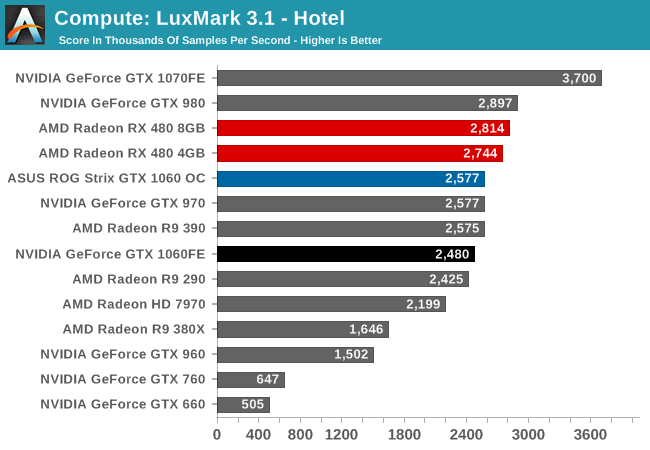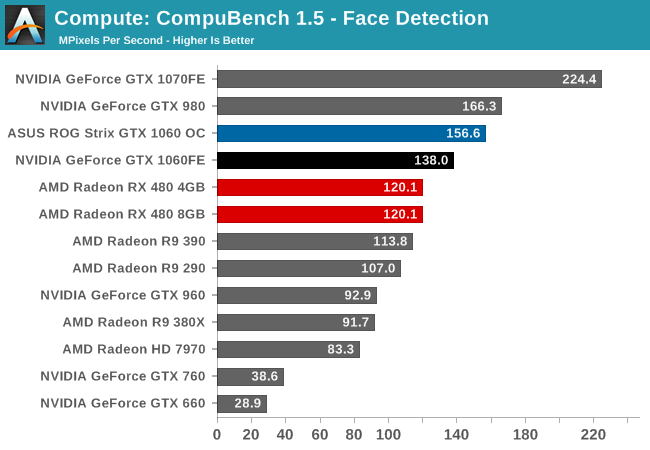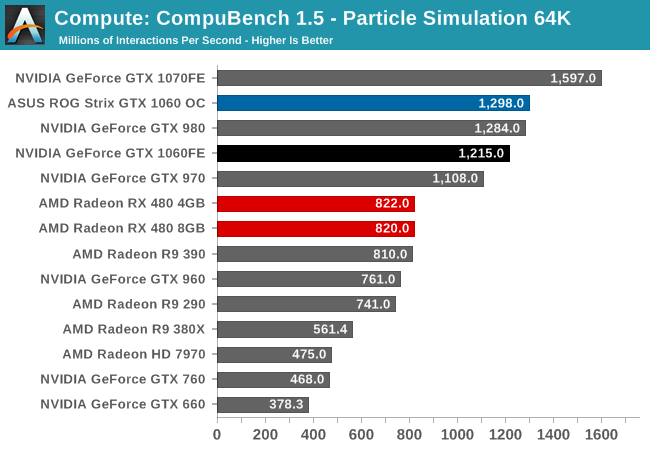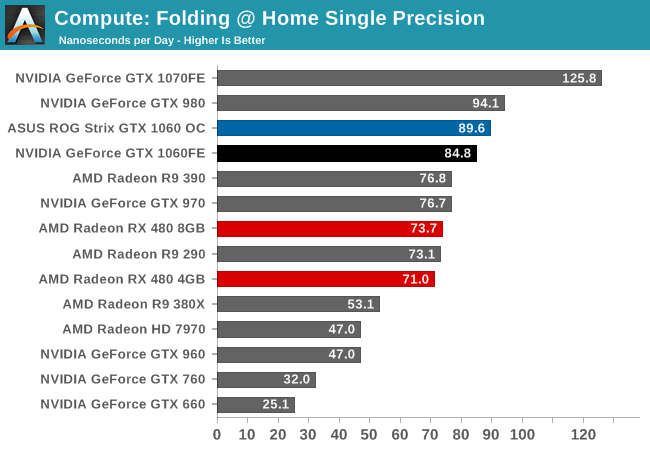The GeForce GTX 1060 Founders Edition & ASUS Strix GTX 1060 Review
by Ryan Smith on August 5, 2016 2:00 PM ESTCompute
Shifting gears, let’s take a look at compute performance on GTX 1060.
As we already had the chance to categorize the Pascal architecture’s compute performance in our GTX 1080 review, there shouldn’t be any surprises here. But it will be interesting to see whether the GTX 1060’s higher ratio of memory bandwidth per FLOP materially impacts overall compute performance.
Starting us off for our look at compute is LuxMark3.1, the latest version of the official benchmark of LuxRender. LuxRender’s GPU-accelerated rendering mode is an OpenCL based ray tracer that forms a part of the larger LuxRender suite. Ray tracing has become a stronghold for GPUs in recent years as ray tracing maps well to GPU pipelines, allowing artists to render scenes much more quickly than with CPUs alone.

While GTX 1060 could hang with GTX 980 in gaming benchmarks, we don’t start off the same way with compute benchmarks, with the last-generation flagship holding about 17% ahead. Unfortunately for NVIDIA, this is about where GTX 1060 needed to be to best RX 480; instead it ends up trailing the AMD competition. Otherwise the performance gain versus the GTX 960 stands at 65%.
For our second set of compute benchmarks we have CompuBench 1.5, the successor to CLBenchmark. CompuBench offers a wide array of different practical compute workloads, and we’ve decided to focus on face detection, optical flow modeling, and particle simulations.



Like with GTX 1080, relative performance is all over the place. GTX 1060 wins with face detection, loses at optical flow, and wins again at particle simulation. Even the gains versus GTX 960 are a bit more uneven, though at the end of the day GTX 1060 ends up being significantly faster than its predecessor with all 3 sub-benchmarks.
Moving on, our 3rd compute benchmark is the next generation release of FAHBench, the official Folding @ Home benchmark. Folding @ Home is the popular Stanford-backed research and distributed computing initiative that has work distributed to millions of volunteer computers over the internet, each of which is responsible for a tiny slice of a protein folding simulation. FAHBench can test both single precision and double precision floating point performance, with single precision being the most useful metric for most consumer cards due to their low double precision performance. Each precision has two modes, explicit and implicit, the difference being whether water atoms are included in the simulation, which adds quite a bit of work and overhead. This is another OpenCL test, utilizing the OpenCL path for FAHCore 21.


Finally, in Folding@Home, we see the usual split between single precision and double precision performance. GTX 1060 is solidly in the lead when using FP32, but NVIDIA’s poor FP64 rate means that if double precision is needed, RX 480 will pull ahead.










189 Comments
View All Comments
fanofanand - Friday, August 5, 2016 - link
Out of curiosity I searched the site, the last comparison of ANY sort was completed on 11/20/13 by you guessed it, Anand himself. Far as I can tell, there has not been a single comparison article written since Anand's departure.Mr Perfect - Friday, August 5, 2016 - link
Sssh! I was trying to get one going, if they hear you they won't do one. >_<Ryan Smith - Friday, August 5, 2016 - link
Anand hasn't written a video card article in about 8 years. You may want to check the byline on that article again.Anyhow, I don't know if we'll do a custom 1060 roundup in particular, but you will be seeing more custom card reviews. This is what Dan Williams is on staff for.=)
Mr Perfect - Saturday, August 6, 2016 - link
Excellent, looking forward to Dan doing some custom card reviews.fanofanand - Saturday, August 6, 2016 - link
I said "of any sort". I actually read the article again because he always had a way of explaining things. I wasn't complaining, this site isn't a "comparison" kind of site.Ranger1065 - Saturday, August 6, 2016 - link
While the same can't be said of the motherboard section, that is an excellent point and something that I very much regret as well. A certain Swedish gentleman does an excellent job in that area, but OMG the English....Ranger1065 - Saturday, August 6, 2016 - link
Perhaps a custom 1080 review by Christmas then. I mean Christmas 2016...xenol - Friday, August 5, 2016 - link
Blower styles are limited to basically the reference design these days, which is now basically limited to the FE cards. The real problem with some of these AIB SKUs is that they're wider than normal. I couldn't fit a MSI Gaming X in my FTZ-01 because the power connectors were too close to the side of the case. I was able to fit a EVGA ACX 3.0 SC in there though and it runs relatively well. It does help the case is compartmentalized more or less.Colin1497 - Friday, August 5, 2016 - link
I know you've been behind, but Rise of Tomb Raider is running faster in DX12 than DX11 on AMD and about the same on both with the 1060 with the latest patches, I believe. Probably what you did with Hitman would be more appropriate? Maybe a one page followup article that includes some analysis and testing with the latest drivers/patches?prisonerX - Friday, August 5, 2016 - link
It's almost comical the way Anandtech cover for Nvidia. Benchmarking Gameworks titles without disclosure, slyly avoiding DX12 and Vulcan game benchmarks (you know, what people will mostly be using these cards with, going forward) that favor AMD.I don't blame them, getting pre-release cards to write reviews is their bread and butter, and Nvidia has not been shy about punishing those who do not toe the line.